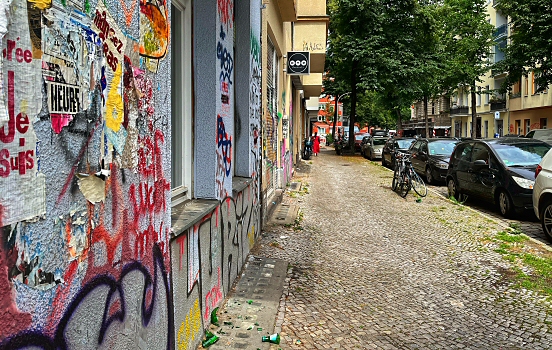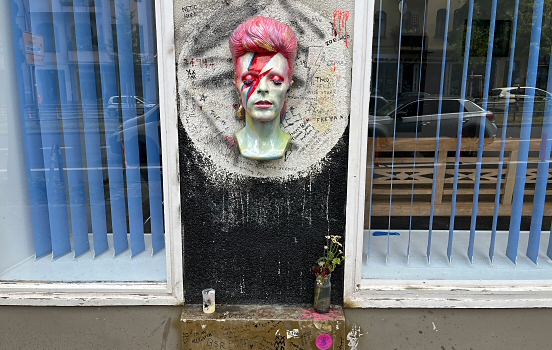Berlin is a city of sounds. Strolling through Kreuzberg or Friedrichshain, I don’t just hear Berlin, I feel it in my chest. That pulsing bass from an underground club I’ll never find again. The clatter of U-Bahn doors slamming shut. A street performer’s accordion warbling off-key. Turkish market vendors shouting over the döner fumes. A kind of sonic chaos with a strange, intoxicating rhythm.
Forget about orchestras and operas. Berlin’s true symphony comes from the anarchic hiss of spray cans tagging naked concrete walls, the techno that never sleeps, and the occasional car horn that’s more a conversation than a complaint. It’s a soundscape stitched together by rebellion and reinvention.
Fortunately, there’s beauty in the grime. A sort of elegance in the mess. I come to Berlin not for serenity, but for the dissonance. For the kind of music that punches me in the ribs and then buys me a beer.
 All is not lost who wander in Neukölln.
All is not lost who wander in Neukölln.
It’s a scorching summer day in Berlin. Coincidentally, it’s been 40 years since the release of Summer in Berlin, the well-known song by German band Alphaville. Yesterday I visited a music festival in Kreuzberg, but today my musical odyssey takes me elsewhere.
I walk along the deserted streets in Neukölln. These days the neighborhood is getting gentrified, but during the 1970s the area was in a derelict state. David Bowie lived in Berlin at the time, often being seen walking alone in Neukölln.
Edgar Froese, co-founder of Tangerine Dream, was from Neukölln. Froese’s album “Epsilon in Malaysian Pale” from 1975 was a big influence on Bowie, who said that it was the soundtrack of his life in Berlin.
I don’t know what other songs the 30-year-old Bowie was listening to in his head, as he roamed the streets in solitude. But I sure know the song on my own mind. Bowie captured the post-apocalyptic mood in the song “Neuköln” (sic) from the album “Heroes”, included in his so-called Berlin Trilogy, where a lonely saxophone cuts through the bleak instrumental soundscape.
 Bowie immortalized at Hauptstraße 55.
Bowie immortalized at Hauptstraße 55.
Bowie first stayed at the home of Edgar Froese, but he soon moved to Hauptstraße 155 in Schöneberg, sharing a seven-room apartment with fellow addict Iggy Pop. Even Brian Eno used to live there for a time. Blixa Bargeld from bands Einstürzende Neubauten and Nick Cave and the Bad Seeds lived around the corner at Langenscheidtstraße, and met them on occasion.
Today the entrance at number 155 has become a shrine, featuring a bust of Bowie. Strangely, the bust depicts his Ziggy Stardust persona, instead of the Thin White Duke that he used during the Berlin years. At the same street is the Neues Ufer café, an old favorite of Bowie and Iggy. Today the place is packed with Bowie posters and memorabilia. For more gritty details about their Berlin years, I recommend the biographies “David Bowie: Starman” and “Iggy Pop: Open Up and Bleed”, both written by Paul Trynka.
Half a lifetime later, Bowie nostalgically looked back in the 2011 song “Where Are We Now?“. Unexpectedly released on his 66th birthday, he reflected on his Berlin years, singing about several places in the city. Even the cover design of the album is a pun on his most famous Berlin record “Heroes”.
“Had to get the train
From Potsdamer platz
You never knew that
That I could do that
Just walking the dead”
— David Bowie, Where Are We Now? (2011)
I continue walking, silently thinking about the new sounds that will come from Berlin in the future.

Comments
No comments yet.
Leave a reply